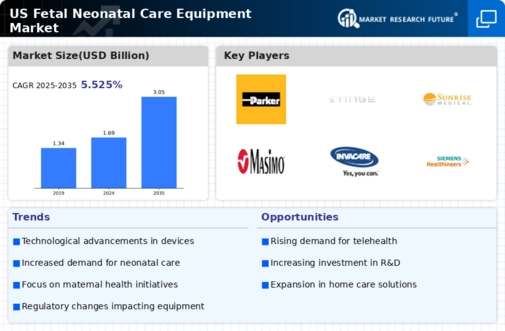The fetal neonatal-care-equipment market is characterized by a dynamic competitive landscape, driven by technological advancements, increasing healthcare expenditure, and a growing emphasis on neonatal care. Major players such as GE Healthcare (US), Philips (NL), and Siemens Healthineers (DE) are at the forefront, each adopting distinct strategies to enhance their market positioning. GE Healthcare (US) focuses on innovation through the development of advanced imaging technologies, while Philips (NL) emphasizes digital transformation and integrated solutions for neonatal care. Siemens Healthineers (DE) appears to be concentrating on strategic partnerships to expand its product offerings and enhance service delivery, collectively shaping a competitive environment that prioritizes technological sophistication and comprehensive care solutions.
In terms of business tactics, companies are increasingly localizing manufacturing to reduce costs and improve supply chain efficiency. The market structure is moderately fragmented, with several key players exerting considerable influence. This fragmentation allows for a diverse range of products and services, catering to various segments of the healthcare market. The collective strategies of these companies indicate a trend towards collaboration and innovation, which is likely to enhance overall market growth.
In October 2025, GE Healthcare (US) announced the launch of a new line of neonatal monitoring systems designed to improve patient outcomes through real-time data analytics. This strategic move underscores the company's commitment to leveraging technology to enhance neonatal care, potentially positioning it as a leader in the market. The integration of advanced analytics into monitoring systems may facilitate better clinical decision-making, thereby improving the quality of care.
In September 2025, Philips (NL) expanded its partnership with a leading healthcare provider to implement a comprehensive digital health platform aimed at streamlining neonatal care processes. This initiative reflects Philips' strategy to integrate digital solutions into traditional healthcare settings, enhancing operational efficiency and patient management. Such partnerships are likely to bolster Philips' market presence and reinforce its commitment to innovative healthcare solutions.
In August 2025, Siemens Healthineers (DE) entered into a collaboration with a prominent research institution to develop AI-driven diagnostic tools for neonatal care. This collaboration highlights the growing trend of AI integration within the healthcare sector, suggesting that Siemens is positioning itself to capitalize on emerging technologies. The focus on AI could lead to significant advancements in diagnostic accuracy and treatment protocols, further enhancing the company's competitive edge.
As of November 2025, the competitive trends in the fetal neonatal-care-equipment market are increasingly defined by digitalization, sustainability, and the integration of AI technologies. Strategic alliances among key players are shaping the landscape, fostering innovation and enhancing service delivery. Looking ahead, it appears that competitive differentiation will evolve from traditional price-based competition to a focus on technological innovation, reliability in supply chains, and the ability to deliver comprehensive, integrated care solutions.


















Leave a Comment